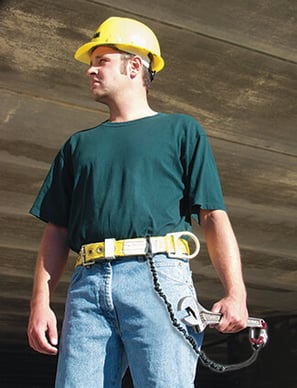ANSI Issues Dropped Objects Standard

Kicking off a campaign to reduce the risks of dropped object incidents, a tool tethering standard has been set for employers by the American National Standards Institute (ANSI) and the International Safety Equipment Association. ANSI/ISEA 121-2018 offers guidance on safety products that help keep tools and other items from falling off workers and equipment from heights. Construction workers, oil and gas industry professionals and other industrial workers can apply safety best practices, including visual communication, to help ensure safety from elevated work areas.
Dangers of Dropped Objects
When hammers, materials, and other worksite objects fall from high-up work areas they pose dangers to workers both at that height, from overreaching, as well as those down on the ground, from stuck-by incidents. There were 255 fatalities from dropped objects and 47,920 injures in 2016, the Bureau of Labor Statistics reports. That trend is expected to continue with a projected increase of 9.1 percent by the end of 2018, BLS reported. Dropped objects attribute to the third leading cause of injuries on a jobsite, according to OSHA.
"The Dropped Object Prevention Group has worked countless hours to help save lives by creating this groundbreaking new standard. We developed it from scratch - it's not a revision of anything - and that makes it particularly significant," said Nate Bohmbach, an associate product director at Ergodyne who also is chair of ISEA's Dropped Object Prevention Group. "The standard kicks off a new generation of tethering practices. A lot of people are tethering their tools and equipment using just duct tape and rope, which is pretty alarming, so this standard guides employers and workers toward safer, more reliable solutions."
Tool Safety Solutions

While this standard is voluntary for employers, tethering systems can prevent an item from falling and causing unnecessary injuries. The Dropped Object Prevention Solutions standard establishes minimum design, performance, and labeling requirements for solutions that prevent falling objects. It also establishes guidelines for testing that equipment. There are four active controls to prevent dropped objects:
- Anchor attachments: Permanent or mobile
- Tool attachments: D-rings
- Tool tethers: Wrist lanyards
- Containers: Pouches and buckets
The standard does not include items such as netting and toe boards, and it does not include personal protective equipment, such as hard hats and other safety wearables.
Employers can re-evaluate job safety to help keep tools and other items from falling off workers and equipment at heights. Include visual communication such as signs to remind workers to use tool anchors or attachments and labels that keep PPE and other items organized. Remind workers of the dangers from working at heights that include overreaching, overloading at a height, and more. Use continuous training and safety education materials to help mitigate hazards such as on scaffolding, rooftops, metal building frames, and ladders.
Related Resources

Improve Falling Objects, Struck-Bys in Construction
Falling objects and struck-bys are some of the most common job hazards that lead to injury or death in ...
Read
Inspection Drones Take Safety to New Heights
Drone inspections are becoming a big benefit for businesses. These aerial devices can enter dangerous work ...
Read
Signs Your Excavation Site Needs Shoring Up
Excavations of all types require a variety of tools and techniques for safety and efficiency. A few things ...
Read.png)





